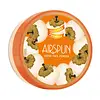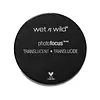What's inside
What's inside
 Key Ingredients
Key Ingredients

 Benefits
Benefits

No benefits
 Concerns
Concerns

No concerns
 Ingredients Side-by-side
Ingredients Side-by-side

Mica
Cosmetic ColorantKaolin
AbrasiveZinc Stearate
Cosmetic ColorantAvena Sativa Kernel Flour
AbrasiveTapioca Starch
Isopropyl Palmitate
EmollientOctyldodecyl Stearoyl Stearate
EmollientCalcium Silicate
AbsorbentParfum
MaskingDimethicone
EmollientSorbitan Sesquioleate
EmulsifyingWater
Skin ConditioningCaprylyl Glycol
Emollient1,2-Hexanediol
Skin ConditioningSodium Benzoate
MaskingAlpha-Isomethyl Ionone
PerfumingEugenol
PerfumingLimonene
PerfumingLinalool
PerfumingCoumarin
PerfumingHydroxycitronellal
PerfumingCinnamyl Alcohol
PerfumingGeraniol
PerfumingCitronellol
PerfumingBenzyl Salicylate
PerfumingAnise Alcohol
PerfumingCitral
PerfumingBenzyl Benzoate
AntimicrobialCI 77891
Cosmetic ColorantCI 77491
Cosmetic ColorantCI 77492
Cosmetic ColorantCI 77499
Cosmetic ColorantMica, Kaolin, Zinc Stearate, Avena Sativa Kernel Flour, Tapioca Starch, Isopropyl Palmitate, Octyldodecyl Stearoyl Stearate, Calcium Silicate, Parfum, Dimethicone, Sorbitan Sesquioleate, Water, Caprylyl Glycol, 1,2-Hexanediol, Sodium Benzoate, Alpha-Isomethyl Ionone, Eugenol, Limonene, Linalool, Coumarin, Hydroxycitronellal, Cinnamyl Alcohol, Geraniol, Citronellol, Benzyl Salicylate, Anise Alcohol, Citral, Benzyl Benzoate, CI 77891, CI 77491, CI 77492, CI 77499
 Reviews
Reviews

Ingredients Explained
These ingredients are found in both products.
Ingredients higher up in an ingredient list are typically present in a larger amount.
Caprylyl Glycol is a humectant and emollient, meaning it attracts and preserves moisture.
It is a common ingredient in many products, especially those designed to hydrate skin. The primary benefits are retaining moisture, skin softening, and promoting a healthy skin barrier.
Though Caprylyl Glycol is an alcohol derived from fatty acids, it is not the kind that can dry out skin.
This ingredient is also used as a preservative to extend the life of products. It has slight antimicrobial properties.
Learn more about Caprylyl GlycolCi 77492 is also hydrated iron III oxide. It's sole purpose is to give a yellow hue to products.
Iron III oxides are classified as inorganic chemicals for coloring.
Synthetically created Ci 77492 is considered safer than those naturally found. This is because the synthetically created version may contain less impurities. Iron oxides are generally non-toxic and non-allergenic.
Learn more about CI 77492Ci 77499 is also hydrated iron III oxide. It is created from mixing red and black iron oxides. This helps give shades of darkness to a product.
Iron III oxides are classified as inorganic chemicals for coloring.
Water. It's the most common cosmetic ingredient of all. You'll usually see it at the top of ingredient lists, meaning that it makes up the largest part of the product.
So why is it so popular? Water most often acts as a solvent - this means that it helps dissolve other ingredients into the formulation.
You'll also recognize water as that liquid we all need to stay alive. If you see this, drink a glass of water. Stay hydrated!
Learn more about Water